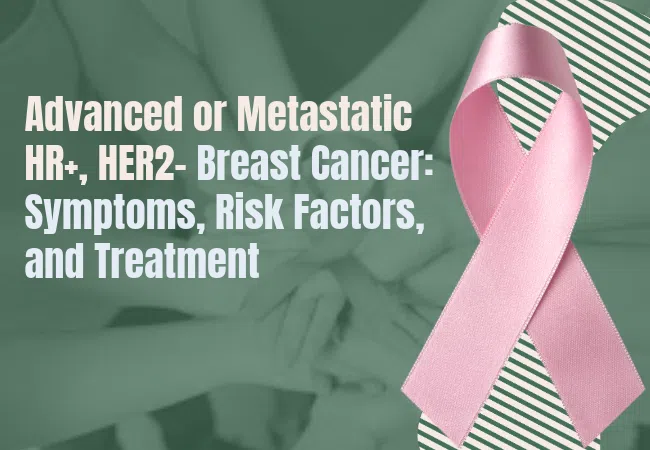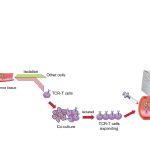Out of all types of breast cancer, Advanced or metastatic HR-positive, HER2-negative breast cancer is the most prevalent, accounting for almost 70% of cases worldwide. In this subtype, cancer cells have estrogen and/or progesterone receptors (HR-positive) but do not overexpress the human epidermal growth factor receptor 2 (HER2). The disease is considered advanced or metastatic when it spreads beyond the breast and regional lymph nodes. In this disease, early detection of changes in symptoms, understanding the major risk factors, and prompt initiation of appropriately targeted therapies greatly help improve outcomes and life quality for patients battling this hormone-responsive cancer.
What is Advanced Metastatic HR+, HER2- Breast Cancer?
Hormone receptor positivity means the cancer cells develop in reaction to estrogen and/or progesterone. HER2 negativity indicates the tumor does not overexpress the HER2 protein. When breast cancer metastasizes, which is often to the bone, liver, lung, or brain, it marks an advanced stage that needs broader treatment than just localized therapy. This subtype tends to be well controlled by endocrine therapies, although resistance can develop. There have been recent breakthroughs in targeted medications such as PI3K/AKT pathway inhibitors, which have added options for endocrine-resistant disease. Endocrine therapy resistance drives changes to precision medicine that rely on accurate targeted therapy, receptor profiling, molecular testing, and performance status.
Symptoms of Advanced Metastatic HR-Positive, HER2-Negative Breast Cancer:
Individuals with advanced HR-positive and HER2-negative breast cancer might have the following symptoms:
- Persistent bone pain: It may indicate bone metastases and occurs most notably in the spine, hips, or ribs.
- Unexplained weight loss and fatigue: It may occur due to systemic involvement alongside tumor burden.
- Shortness of breath or cough: It may indicate metastases in the lungs.
- Jaundice, abdominal pain, or swelling: These may suggest involvement of the liver.
- Neurological changes: These include headaches or seizures and even visual changes, which can indicate brain metastases.
- New breast lump or skin changes: It can still occur in the primary site despite prior treatment.
Though these symptoms may accompany other benign health conditions, emerging and persistent symptoms require immediate attention from healthcare professionals.
Risk Factors for HR+, HER2-Negative Breast Cancer:
Several factors are responsible for increasing the likelihood of developing HR+, HER2- breast cancer and its progression to advanced stages:
- Age and gender: Risk factors increase after 50 years of age and are higher among females.
- Family history and genetics: Having BRCA1/2 mutations and breast cancer in first-degree relatives.
- Hormonal influences: Early menarche, late menopause, or long-term hormone therapy.
- Reproductive history: Late initiation of childbirth leads to nulliparity.
Lifestyle factors: Sedentary lifestyle and obesity or consumption of alcohol. - Previous breast conditions: A known history of atypical hyperplasia or ductal carcinoma in situ (DCIS).
- Prior endocrine therapy: Prolonged exposure to tamoxifen or aromatase inhibitors can select for resistant clones.
Understanding these risk factors helps guide screening intensity and preventive strategies in high-risk populations.
Early Detection and Diagnosis:
A biopsy and mammography together confirm HR and HER2 status. For potential metastases, ultrasounds, PET-CT, MRIs, bone, and CT scans highlight the spread of the disease. Pathology reports provide ER, PR, and HER2 expression levels. Prognosis, along with endocrine sensitivity, may be evaluated with genomic assays such as Oncotype DX. Prognosis, along with treatment planning, is done using the TNM system, which stands for tumor, node, and metastasis. Care from multiple fields combines oncology, radiology, surgery, and pathology, allowing for streamlined multidisciplinary evaluation.
Treatment of Advanced Metastatic HR+, HER2- Breast Cancer:
Treatment focuses on managing the disease, relieving symptoms, and extending life while maintaining quality of life. The following is a systematic therapy:
Endocrine Therapy:
- Aromatase inhibitors such as letrozole and anastrozole
- Selective estrogen receptor degrader fulvestrant
CDK4/6 Inhibitors:
- Palbociclib, ribociclib, and abemaciclib in combination with endocrine therapy
mTOR Inhibitors:
- Everolimus plus exemestane for endocrine-resistant disease
Chemotherapy:
- Single agents (capecitabine, paclitaxel) are reserved for rapid disease control
Targeted Therapy:
Truqap (Capivasertib): It is a potent oral AKT inhibitor for patients with advanced or metastatic HR-positive, HER2-negative breast cancer who have previously been treated with an endocrine therapy and a CDK4/6 inhibitor. Truqap works by inhibiting the AKT pathway, which is a major contributor to tumor cell survival and resistance to endocrine therapy, thereby restoring the ability to respond to hormonal treatments and improving progression-free survival. In phase III trials, this medicine, when added to fulvestrant, resulted in a greater reduction in disease progression compared to patients receiving fulvestrant alone, and it was well-tolerated.
Continued studies are being done to optimize sequencing and combining resistant PI3K, AKT, and mTOR inhibitors.
What is Truqap in India?
Truqap in India has not yet been approved by the CDSCO. Indian patients can access Truqap only via a Named Patient Program (NPP), under physician supervision and through licensed importers like Indian Pharma Network (IPN). We offer compliant and personalized import services.
What is the Truqap price in India?
Truqap price in India generally varies based on dosage, shipment size, and NPP service fees. Since it isn’t CDSCO‑approved, the cost includes the medicine, import duties, and handling. For precise Truqap price in India under NPP, contact a licensed importer like IPN for a tailored quotation.
How can I buy Truqap online in India?
To buy Truqap online in India, secure a doctor’s prescription for off‑label use, then engage a licensed NPP importer. They guide you through online order placement, regulatory paperwork, and secure courier delivery, ensuring compliance with India’s Named Patient Program requirements.
Who is the Truqap importer in India?
A Truqap importer in India must hold CDSCO and DGFT NPP licenses. Leading importers include Indian Pharma Network. We are authorized NPP specialists who manage regulatory approvals, documentation, and GDP‑compliant logistics to deliver this medicine safely.
How do I buy Truqap through the Named Patient Program in India?
To buy Truqap through the Named Patient Program in India. A licensed importer like IPN arranges procurement, customs clearance, and cold‑chain delivery. This pathway allows patients access to unapproved medicine under strict regulatory oversight.






